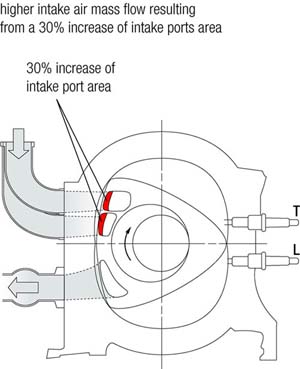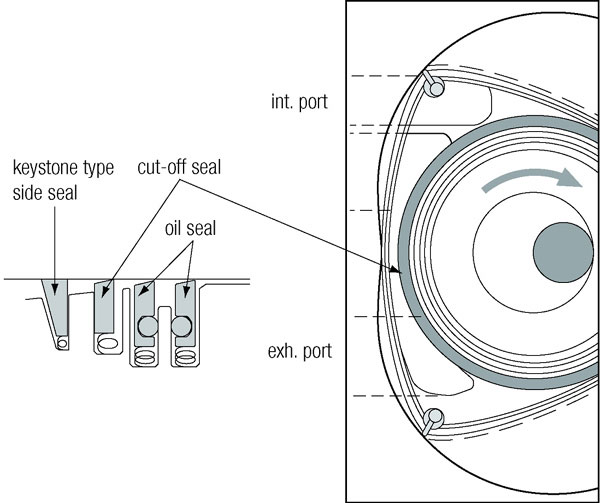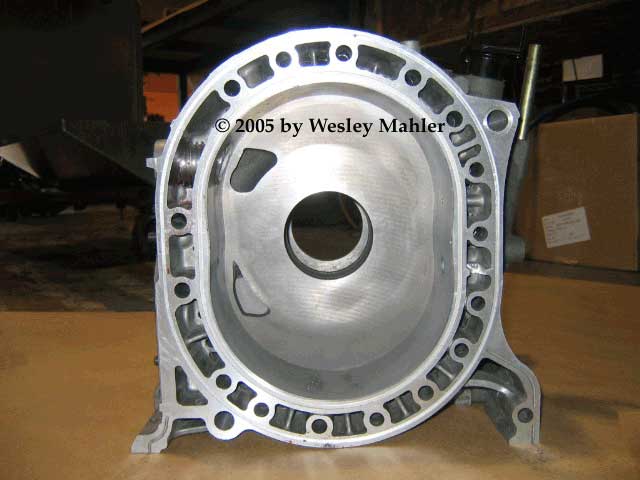| View previous topic :: View next topic |
| Author |
Message |
NarendZORCE
Zorce Editor-in-Chief

Joined: 04 Apr 2005
Posts: 3137
Location: In Zorce, usually after the contents page
|
 Posted: Thu Jan 19, 2006 5:23 pm Post subject: The Renesis Engine Posted: Thu Jan 19, 2006 5:23 pm Post subject: The Renesis Engine |
 |
|
Source: Mazda

Next-generation Renesis Rotary Delivers Driving Excitement
The RX-8�s Renesis rotary engine has its origins in the MSP-RE powerplant unveiled at the 1995 Tokyo Motor Show under the bonnet of the RX-01 concept sports car. The name Renesis, which stands for �the Rotary Engine�s geNESIS,� was given to the engine in the 1999 iteration of the RX-EVOLV.

Renesis � an engine boasting innovative technologies such as side intake/side exhaust porting � is a 654 cc x two rotor unit that generates 177kW (ECE) at 8200 rpm and 211Nm (ECE) of torque at 5500 rpm when mated to a six-speed manual transmission. Renesis also shows substantial fuel efficiency and emission improvement over the RX-7�s engine.
Manual models accelerate from standstill to 100kmh in 6.2 seconds.
By capitalising on the intrinsic benefits of the Renesis rotary engine � namely, low weight, compact size and high performance � Mazda succeeded in developing the RX-8, a wholly new concept four-door, four-seat sports car.
Basic Characteristics Of Side Intake/Side Exhaust Port Layout
The key technology of Renesis is its side exhaust port configuration, with the exhaust ports relocated to the rotary chamber side housing alongside the intake ports.
The chief advantage of this layout is the elimination of intake/exhaust port timing overlap. This measure ensures that exhaust gas is not retained and carried over to the next intake cycle, thereby promoting more stable combustion and better fuel economy.
The engine also has two exhaust ports per rotor chamber, giving Renesis almost twice the exhaust port area of its predecessor. With ample exhaust port area assured, delaying the opening of the exhaust ports affords Renesis a longer expansion cycle, for improved thermal efficiency, power output and fuel economy.

Side exhaust ports also allow engineers more freedom to optimise port profiles. With Renesis, both the six-port High Power version (manual transmission) and four-port Standard Power version (automatic transmission) have almost 30 per cent more intake port cross-sectional area than the previous engine. Additionally, the intake port close timing has been extended, resulting in increased charging volume and more power.
With the previous engine, unburned gases (hydrocarbons) were voided from the combustion chamber via the peripheral port. With the side-exhaust ports of the Renesis, unburned gases are retained for burning in the next combustion cycle, further reducing regulated emissions.
Mazda began developing rotary technology in 1961, and since the late seventies has been the world�s only rotary engine manufacturer to depend entirely on manufacturing technology and equipment developed in house.
Renesis A High Tech, High Output Engine
Synthetic Intake System For Variable Valves: The side-intake/side-exhaust port Renesis gains 30 per cent in intake port area over the previous engine, and this, combined with the delayed intake port close timing, makes for a sizable increase in charging volume resulting in greater power output. The engine also incorporates innovative technology designed to boost filling efficiency.

The High Power specification engine (manual model) has three intake ports per rotor chamber: primary, secondary and auxiliary (giving a total of six intake ports for the twin rotor Renesis engine), with each subject to different timing. The variable intake control system operates opening/closing of the secondary and auxiliary intake ports. Renesis also takes full advantage of the incoming air�s dynamic charge effect to boost charging for more substantial low-to-mid range torque, as well as increased torque and power output at higher engine speeds. The intake system on the Standard Power unit (Activematic model), which is tuned for superb driveability at normal rpm, has two intake ports per rotor, for a total of four intake ports. These are controlled by the opening/closing of a variable intake valve governing use of the secondary intake port. For even more accurate control, Renesis incorporates an electronic throttle control system that optimises intake control in response to feedback of sensors monitoring the degree and speed of accelerator pedal operation.

Variable Fresh Air Duct (FAD): The High Power specification engine mated to the six-speed manual transmission incorporates a variable fresh air duct in addition to a large, low resistance air cleaner. At about 7250 rpm, a shutter valve opens to shorten the intake manifold upstream of the air cleaner. The shutter valve works in tandem with the variable intake valve to boost torque and power at high engine speeds. The fresh air duct is partially inserted into the air cleaner and enables an optimal length intake system by valve opening/closing.
Straight Exhaust System Layout: To achieve a smooth flow of exhaust gases, the Renesis exhaust system, including the exhaust manifold, was made as straight as possible. The system employs large diameter exhaust pipes and a high capacity main silencer with the inlet pipe located straight through the centre of the silencer body to reduce flow resistance. These measures contribute to the engine�s high power output.
Technology For Improved Engine Response
Lightweight Rotor, Three Injectors Per Rotor, And Long-Span Engine Mount: The previous 13B-REW engine generated its maximum power output at 6500 rpm, whereas the Renesis power peak comes in at 8200 rpm. This step-up to a higher revving engine was achieved by virtue of an 11 per cent reduction in rotor weight. Additionally, the flywheel weight has been reduced by some 20 per cent compared with the previous engine. Combined, these weight-saving measures reduce inertia to assure the quick response befitting a genuine sports car engine.

Renesis also features three injectors per rotor chamber for improved fuel atomisation and employs an electronically controlled throttle and 32-bit PCM (Powertrain Control Module) for more precise control of air-fuel metering and sharper throttle response. Additionally, the engine uses a long span engine mount system with extremely long members extending laterally from the rotors� axis. The mounts are effective in suppressing engine vibration, allowing more direct transmission of power to the drive system and contributing to the vehicle�s fast response and improved NVH.

Technology For Low Vibration, Distinctive Rotary Sound
Dynamically Balanced Rotors: To further refine the superior balance of the twin-rotor configuration, Mazda shifted from the previous static balance setting and instead adopted dynamic balance calculated from the mass of oil entering the rotors. This improvement, together with the effect of the long span engine mount system (mentioned previously) realises extremely low vibration during acceleration.
Counter-Rotating Fixed Gear And Tuning Of The Intake Sound: With the previous rotary engine, the direction of rotation of the fixed gear locating the rotors in the front and rear housing was the same for both rotors. With Renesis, the direction is reversed for front and rear rotors, achieving smoother rotation and reduced gear noise. Mazda also tuned the intake to give a satisfyingly sporty sound.
Technology For Fuel Economy
In addition to more stable combustion afforded by the side exhaust ports, as well as improved breathing efficiency, Renesis also shows a significant gain in fuel-efficiency through the use of the following new technologies.

Newly Designed Seals: Renesis employs a new cut-off seal located between the rotor�s dual oil seals and side seal. This sealing arrangement eliminates blow-by between intake and exhaust ports and prevents carry-over of exhaust gas to the next intake cycle. Side seals are a new keystone-type with wedge-shaped section. Exhaust gas build-up against the side seal can easily cause carbonisation, but with the wedge-shaped or cuneiform side seal, the seal shape is optimised to remove carbon. The shape is also more congruent to its opposed frictional surface, achieving much better sealing proficiency.

Jet Air-Fuel Mixing System: This system is installed in intake ports to promote spray, atomisation and mixing of air and fuel. The system emits a jet of air from a constricted tube in the intake port that effectively speeds the flow of fuel over the intake port walls and boosts atomisation of fuel particles adhering to the walls. The lower end of the intake port is also shape-optimised to induce transport of atomised fuel along the air stream towards the spark plug.
Micro-Electrode Spark Plugs: The last technology employed in aid of fuel economy for the Renesis engine is the micro-electrode spark plug. This spark plug uses a small side electrode and thick gauge central electrode with an extremely fine tip that promotes stable ignition of lean air-fuel mixtures. Also, by maintaining a lower temperature for side and central electrodes, the plug achieves high heat-resistance. The tip of the central electrode, which was previously of platinum, is now made of longer-lasting iridium.
Technology For Lower Emissions
Reduction Of Unburned Gas Emission And Fast Activating Catalytic Converter: The Renesis engine retains unburned hydrocarbons from one cycle for combustion in the next � a process that vastly reduces emission of unburned gases in the exhaust. In addition, on starting the engine, secondary air is supplied to the exhaust port by an electric pump. Delivering secondary air in the gap between the dual exhaust ports promotes mixing of exhaust gas with secondary air to promote re-burning.
Furthermore, Renesis has a dual skin exhaust manifold that maintains the temperature of burned gases and ensures that exhaust temperature rises sharply on starting, for faster activation of the high-performance catalytic converter and consequently low Euro Stage III emissions.
Latest Control Technology For Precision Control Of Air-Fuel Ratio: The fuel metering system for the Renesis engine is also new. Firstly, the previous intake manifold pressure-sensing system for metering air intake volume has been replaced with the hot wire air-flow metre type for more precise metering. Also, the single-loop air-fuel ratio feedback control employing an O2 sensor located upstream of the catalytic converter has been replaced with a double-loop system featuring O2 sensors upstream and downstream of the catalytic converter. The upstream O2 sensor is a linear type achieving straight-line response to a wide-range of air-fuel ratios, promoting precise fuel control from idling to high engine speeds. Combined with the exhaust gas re-burning system (mentioned previously) this reduces exhaust emissions to one tenth the amount recorded for the previous rotary engine.

Technologies For Compact Size And Lighter Weight
Thinner Engine Ribs, Wet Sump Lubrication System And Plastic Intake Manifold: Mazda employed supercomputer analysis to reduce the thickness of supporting ribs for the engine side housing and other areas while maintaining high rigidity. Additionally, approximately half the length of the long intake manifold is now made of plastic. Mazda also cut weight by eliminating the mounting bracket for the air conditioner�s condenser, replacing it with a direct-mount arrangement. Measures such as these, combined with further downsizing of equipment helped reduce overall engine weight. Renesis also has a wet sump lubrication system with oil pan depth reduced by about 40mm to approximately half that of the previous rotary engine. Taken together, the inherently compact size of the naturally aspirated Renesis engine, plus these extensive downsizing and weight-reducing measures, have yielded an engine weight on a par with all-aluminium, in-line, four-cylinder engines.
Last edited by NarendZORCE on Thu Jan 19, 2006 5:46 pm; edited 1 time in total |
|
| Back to top |
|
 |
NarendZORCE
Zorce Editor-in-Chief

Joined: 04 Apr 2005
Posts: 3137
Location: In Zorce, usually after the contents page
|
 Posted: Thu Jan 19, 2006 5:30 pm Post subject: Posted: Thu Jan 19, 2006 5:30 pm Post subject: |
 |
|
Source: http://www.tmp.rotaryengineillustrated.com/renesis.php
The new rotary port configuration.

Rotary intake and exhaust ports are located in a separate engine plates from the ones that actually house the rotor and injectors. All the plates are sandwiched together to make an engine.

This is an actual rotor

Various Views of the Renesis:





























_________________
Drags, Circuit, Solodex, Rally, Karting, the Shows, the Girls, the Car you drive...
ZORCERs done know... the speed lifestyle magazine in the Islands, ZORCE
Click to hear it >> http://www.zorce.com/fortheforums/Zorce15NEW.mp3
Download & SEE iT! >> http://www.zorce.com/fortheforums/Zorce-15.mp4
...........................................................
Oh Yeah! Feel the Rush, it's like... WOW!
May the (Mass x Acceleration)-F+Z be with you... |
|
| Back to top |
|
 |
demented
Pumpum Conqueror

Joined: 21 Sep 2005
Posts: 22
Location: In The Woods.....southside
|
 Posted: Sat Jan 28, 2006 9:26 am Post subject: Posted: Sat Jan 28, 2006 9:26 am Post subject: |
 |
|
VERY informative read there....I love that engine!
_________________
"God's Greatest Creation: THE ROTARY ENGINE!"
 |
|
| Back to top |
|
 |
Plex
Zorce Jedi Master
Joined: 01 May 2005
Posts: 9039
Location: T&T
|
 Posted: Mon Jul 31, 2006 5:24 pm Post subject: Posted: Mon Jul 31, 2006 5:24 pm Post subject: |
 |
|
| good infor.. |
|
| Back to top |
|
 |
|
|
|
|
You cannot post new topics in this forum
You cannot reply to topics in this forum
You cannot edit your posts in this forum
You cannot delete your posts in this forum
You cannot vote in polls in this forum
|
Powered by phpBB © 2001, 2005 phpBB Group
|